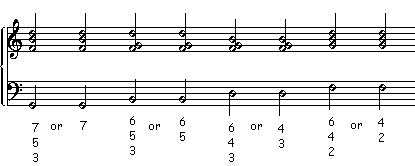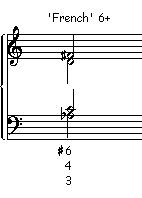
Figured bass in the 17th-18th centuries was a sort of shorthand notation that described the intended harmony to be combined with a given bass. The figures tell what intervals need to be added to the bass note in order to sound the desired harmony. These figures are written in their simplest form: for example, a "6" will mean that the bass note needs a sixth above, but that sixth can be in any octave. In practice a "6" just means that this is the bass of a first-inversion chord (more on that below). The figures also assume that the added notes will be within the key unless otherwise indicated: it's not necessary to specify whether an interval is major, minor, perfect, or diminished - it will be whatever is natural to the key. If the composer means for one of the other notes to be lowered or raised from what it would be in the key, the number can be combined with an accidental: a sharp, flat, or natural, as needed. Sometimes a slash is drawn through a number to show it is raised, and sometimes a "+" is used to show the same thing. If you see an accidental with no number attached it is always referring to the 3rd.
Note: for typographic reasons, figures will be indicated here separated by slashes. In the music the figures will appear one above the other.
A triad in root position would be indicated by 5/3. As this is such a common figure it is generally not written unless one of the two pitches needs to be altered. Therefore, if you see a bass note with no figure the implication is that this is the root of a triad.
If you see "#3" or a "b3," without a "5" or just "#" or "b," that means that the bass is the root of a triad whose third needs to be raised or lowered from what it would otherwise be in the key signature.
A triad in first inversion would be indicated by 6/3. However, as with the 5/3 the figure is abbreviated in practice: just the 6 is shown unless one of the two needs alteration. If you see a bass with a "6" underneath that means the bass note is the third of a triad; the triad is in first inversion.
A triad in second inversion would be indicated with a 6/4, and in this case both numbers are always provided so that this is easily distinguished from the first inversion. The bass in this case is the fifth of a triad.
With seventh chords additional figures are possible:
A seventh chord in root position would be 7/5/3 if completely figured. In practice this is abbreviated to just "7." A seventh chord in first inversion would be 6/5/3, and is abbreviated to 6/5. A seventh chord in second inversion would be 6/4/3, and is abbreviated to 4/3.
A seventh chord in third inversion would be 6/4/2, and is abbreviated to 4/2.

Figured bass provides no explicit indication of a secondary dominant or a modulation; everything is implied by the changes in the figures. For example, if a composer intended what we would now call "V of V" in a major key - that is, a ii chord modified so that it can sound like the V in the key of the dominant (V) chord - it was enough to write a bass taken from the ii chord and to indicate in the figure that this was to be made major by raising the third: a simple "#" would be enough for a root position chord. If the altered chord were in first inversion the bass note would already be carrying an added natural or sharp and so a "6" would still be sufficient. If that secondary dominant were in second inversion the 6 would be raised: #6/4.
The same techniques can be used to indicate any chord: for example, an augmented sixth chord of the "French" type could be indicated by writing a lowered sixth degree as the bass, combined with the figures #6/4/3.

A composer might indicate a desired suspension using figured bass. For example, the suspension of a fourth resolving to a third could be written as "4 3" under a given bass note. A suspension involving a change of bass could also be indicated in figures, with the second figure changed to a number appropriate to the second bass note. Other dissonances and "non-chordal tones" are not indicated in figured bass, however, as this would complicate the reading and also remove that element of improvisation that is an important part of the style (if one is going to indicate every single passing or neighbor tone one might as well just write out all the parts).
It's easiest if you don't try to write all of any voice at once, although you could try writing at least part of just a soprano melody and then fill in the other voices one chord at a time. Write a note for each voice that is in the appropriate range and expresses the chord indicated by the figure, paying attention to the principles of voice leading as expressed in the style rules for 'Bach vocal.' As you go, try to add to the interest of the composition by filling in some leaps of a third with passing tones, and introduce accented dissonances such as suspensions or even an appogiatura or two. Try to imagine singing each part, and adjust wherever possible to make a better singing line in each voice.
A passing tone can be used to fill in almost any leap of a third if it doesn't cause an objectionable combination with another voice. That doesn't mean you should eliminate all melodic thirds, however; this is a matter of taste.
Neighbor tones are a little more problematic, partly because they can easily seem trivial. One thing to look out for: avoid using a lower neighbor tone if it forms a second or a seventh with another voice. That will lead to an unnatural resolution of the second or seventh (both of which typically resolve by letting the lower tone descend).
The suspension is one of the most gratifying of effects when done well. Here are some tips for writing an effective suspension into your composition.
a. Find a chord on a strong beat (one or three in four/four time) in which a pitch in the upper voices that forms a 3rd or 6th with the bass is preceded by a note one step above.
b. Delay the arrival of that 3rd or 6th by tying the preceding note forward. Try to see that the note tied forward is at least as long as the note it is tied to.
c. Make sure that the pitch class of that 3rd or 6th is not doubled in one of the other voices. The suspension is not very effective if the note of resolution is already present in the strong beat chord (though we do know what's going to happen, this is still like giving away the ending of a mystery).
Though you should keep the primary bass notes, it is permitted to fill in with passing tones where you think appropriate. In these exercises the figures will apply just to the downbeat notes that correspond to the Roman numeral analysis; if you want to change the value of a figured quarter note to an eighth and add an eighth note passing tone after it, you can do so without contradicting the harmony.
©2011 Ars Nova Software, LLC